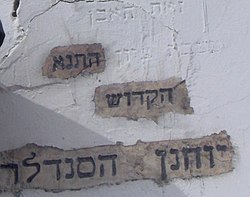| Revision as of 13:57, 14 September 2011 editChesdovi (talk | contribs)Autopatrolled, Extended confirmed users22,098 edits Johanan the Sandalmaker← Previous edit | Revision as of 07:44, 15 September 2011 edit undoDebresser (talk | contribs)Autopatrolled, Extended confirmed users, Pending changes reviewers, Rollbackers, Template editors110,467 edits Restore Template:Eras of the Halakha. Template is on hundreds of similar articles. Should not be removed without general consensus.Next edit → | ||
| Line 1: | Line 1: | ||
| {{Eras of the Halakha}} | |||
| ], ]]] | ], ]]] | ||
| '''Johanan HaSandlar''' (lit. "Johanan the Shoemaker" or "Johanan the Sandalmaker", alternatively "Johanan the Alexandrian") ({{lang-he|יוחנן הסנדלר}}) (c. 200 CE – c. 300 CE) was one of the main students of ] and a contemporary of Rabbi ]. He is one of the '']'' whose teachings are quoted in the ]. The name "HaSandlar" may imply that Rabbi Yohanan earned his living as a ], but it could also indicate that he was a native of ], ].<ref name="Steinsaltz1993">{{cite book|author=Adin Steinsaltz|title=The Talmud: The Steinsaltz Edition : Tractate Ketubot|url=http://books.google.com/books?id=UwomAQAAIAAJ|accessdate=14 September 2011|date=23 November 1993|publisher=Random House|isbn=978-0-679-42694-3|page=88}}</ref> | '''Johanan HaSandlar''' (lit. "Johanan the Shoemaker" or "Johanan the Sandalmaker", alternatively "Johanan the Alexandrian") ({{lang-he|יוחנן הסנדלר}}) (c. 200 CE – c. 300 CE) was one of the main students of ] and a contemporary of Rabbi ]. He is one of the '']'' whose teachings are quoted in the ]. The name "HaSandlar" may imply that Rabbi Yohanan earned his living as a ], but it could also indicate that he was a native of ], ].<ref name="Steinsaltz1993">{{cite book|author=Adin Steinsaltz|title=The Talmud: The Steinsaltz Edition : Tractate Ketubot|url=http://books.google.com/books?id=UwomAQAAIAAJ|accessdate=14 September 2011|date=23 November 1993|publisher=Random House|isbn=978-0-679-42694-3|page=88}}</ref> | ||
Revision as of 07:44, 15 September 2011
| Rabbinical eras |
|---|

Johanan HaSandlar (lit. "Johanan the Shoemaker" or "Johanan the Sandalmaker", alternatively "Johanan the Alexandrian") (Template:Lang-he) (c. 200 CE – c. 300 CE) was one of the main students of Rabbi Akiva and a contemporary of Rabbi Shimon bar Yochai. He is one of the tannaim whose teachings are quoted in the Mishnah. The name "HaSandlar" may imply that Rabbi Yohanan earned his living as a shoemaker, but it could also indicate that he was a native of Alexandria, Egypt.
Rabbi Yochanan was a great-grandson of Rabbi Gamaliel the Elder; he also purportedly traced his ancestry back to King David. Rashi, the great medieval commentator, was a 33rd-generation descendant of Rabbi Yochanan.
He is well-known for his saying in the Mishnah of Pirkei Avoth (4:14): "Every assembly that is for the sake of Heaven will survive; but if it is not for the sake of Heaven, it will not survive."
He died on the 29th day of the Hebrew month of Tammuz (the same yahrzeit as that of Rashi), and was buried 200 meters from the tomb of Shimon bar Yochai in Meron, Israel.
References
- Adin Steinsaltz (23 November 1993). The Talmud: The Steinsaltz Edition : Tractate Ketubot. Random House. p. 88. ISBN 978-0-679-42694-3. Retrieved 14 September 2011.
- Rabbi Yehiel Ben Shlomo Heilprin - Later Achronim